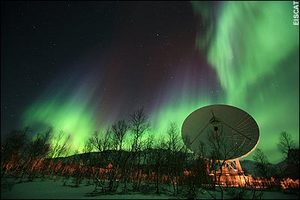The cosmic stunt marks a small step for man, a giant leap for advertising hype and underlines the desperation of British astronomers to find new sources of funding as they struggle to cope with swingeing cuts that now threaten institutions such as Jodrell Bank, the world famous observatory in Cheshire.
Although each and every television advert already broadcast has leaked into the heavens, the caper marks the first time one is to be targetted at an other worldly market, a zone in the constellation Ursa Major that could harbour alien worlds, the snack manufactuer Doritos announces today.

|
| ©Telegraph (UK) |
| The EISCAT Space Centre in Svalbard, Norway will broadcast the ad |
The project, in which the public are invited to shoot a 30 second advert, underlines the current crisis in funding astronomy, due to an £80 million shortfall.
For broadcasting the advert into space, encoded as ones and zeros that clever aliens should be able to figure out, Doritos will make an undisclosed donation to astronomers and academics from Leicester University and Eiscat (The European Incoherent SCATter Scientific Association).
The space-bound ad will broadcast from a 500MHz Ultra High Frequency Radar from the EISCAT Space Centre in Svalbard, Norway, used to study the atmosphere and northern lights, which has escaped a savage round of cuts because its five year renewal contract has been signed.
Prof Tony van Eyken, Director of Eiscat, admits he does not know what the effects of the UK cuts will be but says he is happy to accept any novel source of funding: "Broadcasting an advert extra terrestrially is a big and exciting step for everyone on Earth as up until now we have only tended to listening for incoming transmissions."
When Nasa recently beamed a Beatles song towards the North Star, 431 light years from Earth, some experts warned that the signals could expose us to the risk of attack from mean spirited aliens.
"In this case we are giving somebody the opportunity to create this message as a way to say hello on behalf of mankind," says Prof van Eyken, who adds the prospect of the Earth being destroyed by Doritos hating aliens is remote. "No, I am not worried."
Humans have been announcing their presence by radio and TV broadcasts for decades and when it comes to the Nasa broadcast, "this is a 1,000 light year round trip, it's highly unlikely it will ever be received by extra-terrestrials."
However, he adds that in this case "there is a much greater chance that the Doritos advert will potentially be seen by billions of aliens."
The transmission will be invisible to earthlings and is being directed at a solar system 42 light years away from Earth with planets that orbit its star '47 Ursae Majoris' (UMa). 47 UMa is located in the 'Ursa Major' Constellation, also known as the Great Bear or Plough.
He adds "we have no way to know whether there is extraterrestrial life out there."
As part of its new 'You Make It, We Play It' campaign, Doritos will also air the advert on the more conventional medium of British television in June. The filmmaker responsible for the winning ad will also win £20,000.
The Royal Astronomical Society has talked about its "deep pessimism and anger" at the cuts. Although it welcomes a consultation by the Science and Technology Facilities Council, STFC, the Society remains "deeply concerned" about the impact on UK research in astronomy, space science and solar-system physics.
The RAS does not, however, accept the STFC's classification of many projects as 'lowest priority', which include the £2.5 million running costs for "e-Merlin" - an upgrade to the Multi-Element Radio Linked Interferometer Network between the UK's seven radio telescopes, notably Jodrell, which would struggle if this funding were lost.
Some of these have a high profile, it says, including eMerlin, the Gemini Observatory and UK involvement in the Hinode space observatory currently being used to study activity on the Sun.
Alongside the risks to these and other projects is a 25 per cent cut in the STFC research grants to universities that will see numbers of postdoctoral researchers in space science and astronomy fall to their lowest level for seven years.
There is also a real concern that the consultation with the science community on the Review is too brief for responses to be heard. This began this week and will close on 21 March - by comparison UK Government guidelines on public consultation suggest a minimum period of 12 weeks.
President of the Royal Astronomical Society, Prof Michael Rowan-Robinson says: "I welcome the commitment by STFC to consult with the wider community on what remains a severe package of cuts. It is vital that the consultation is as fair and transparent as possible so that the eventual decisions are seen to be made on an objective basis.
"Closing down UK involvement in a swathe of projects will harm our ability to carry out cutting-edge research, our international reputation and our ability to attract young people into science and physics in particular."



Reader Comments
to our Newsletter